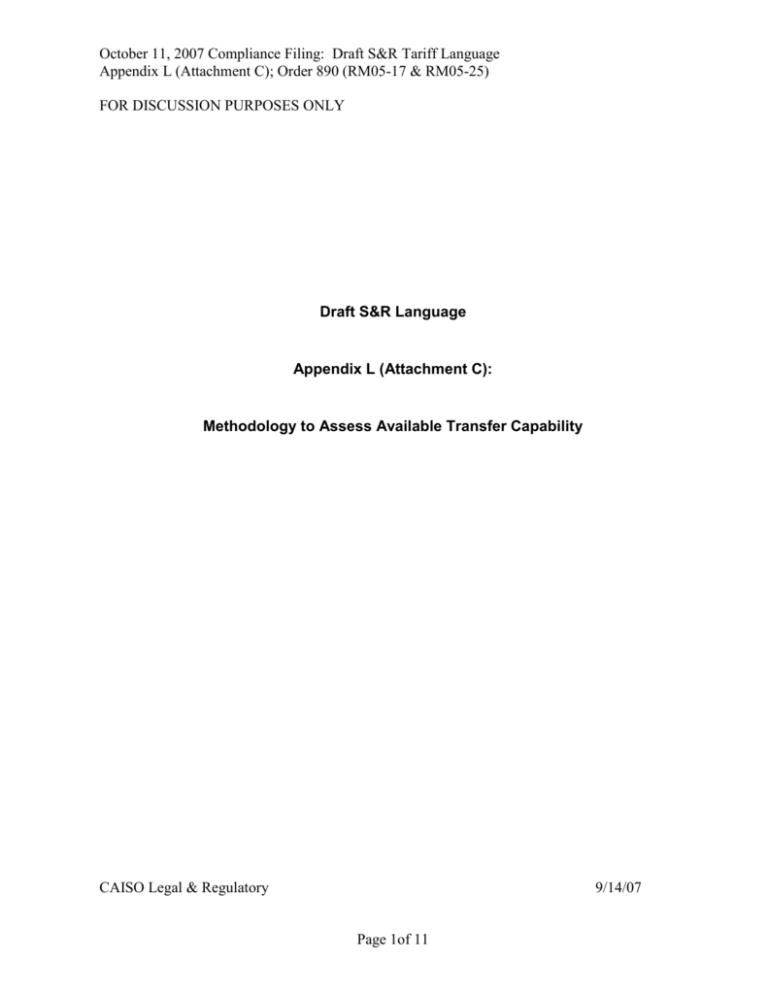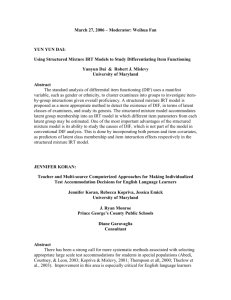Methodology to Assess Available Transfer Capability
advertisement

October 11, 2007 Compliance Filing: Draft S&R Tariff Language
Appendix L (Attachment C); Order 890 (RM05-17 & RM05-25)
FOR DISCUSSION PURPOSES ONLY
Draft S&R Language
Appendix L (Attachment C):
Methodology to Assess Available Transfer Capability
CAISO Legal & Regulatory
9/14/07
Page 1of 11
October 11, 2007 Compliance Filing: Draft S&R Tariff Language
Appendix L (Attachment C); Order 890 (RM05-17 & RM05-25)
FOR DISCUSSION PURPOSES ONLY
Attachment C – Methodology to Assess Available Transfer Capability
C.1
Description of Terms
The following descriptions augment existing definitions found in Appendix A “Master
Definitions Supplement.”
C.1.1
Available Transfer Capability (ATC) is a measure of the transfer
capability in the physical transmission network resulting from system conditions and that
remains available for further commercial activity over and above already committed
uses.
ATC is defined as the Total Transfer Capability (TTC) less applicable operating
Constraints due to system conditions and Outages (i.e., OTC), less the Transmission
Reliability Margin (TRM), less the total of Existing Transmission Commitments (ETC),
less the Capacity Benefit Margin (CBM).
C.1.2
Total Transfer Capability (TTC) is defined as the amount of electric
power that can be moved or transferred reliably from one area to another area of the
interconnected transmission system by way of all transmission lines (or paths) between
those areas. In collaboration with owners of rated paths and the WECC Operating
Transfer Capability Policy Committee (OTCPC), the CAISO utilizes Rated Path
Methodology to establish the TTC of CAISO branch groups.
C.1.3
Operating Transfer Capability (OTC) is the TTC reduced by any
operational Constraints caused by seasonal derates or Outages. CAISO Regional
Transmission Engineers determine OTC through studies using computer modeling.
C.1.4
Existing Transmission Commitments (ETC) include Existing Contracts,
and as appropriate, Firm Transmission Rights, and Transmission Ownership Rights.
C.1.5
Transmission Reliability Margin (TRM) is that amount of transmission
transfer capability necessary to ensure that the interconnected transmission network is
secure under a reasonable range of uncertainties in system conditions. TRM reserves
sufficient transmission capacity from the Day-Ahead (DA) Market to ensure that the
interconnected transmission network is secure under a reasonable range of
uncertainties in system conditions. This DA implementation avoids real time schedule
curtailments that would otherwise be necessary due to:
Load forecast error
Anticipated uncertainty in transmission system topology
Unscheduled Flow
Simultaneous path interactions
Variations in generation dispatch
CAISO Legal & Regulatory
9/14/07
Page 2of 11
October 11, 2007 Compliance Filing: Draft S&R Tariff Language
Appendix L (Attachment C); Order 890 (RM05-17 & RM05-25)
FOR DISCUSSION PURPOSES ONLY
Operating reserve actions
The level of TRM for each branch group will be determined by CAISO Regional
Transmission Engineers (RTE).
C.1.6
Capacity Benefit Margin (CBM) is that amount of transmission transfer
capability reserved by Load Serving Entities (LSEs) to ensure access to generation from
interconnected systems to meet generation reliability requirements. In the DA Market,
CBM may be used to provide reliable delivery of Energy to CAISO Control Area Loads
and to meet CAISO responsibility for resource reliability requirements in real time. The
purpose of this DA implementation is to avoid real time schedule curtailments and firm
load interruptions that would otherwise be necessary. CBM may be used to reestablish
Operating Reserves. CBM is not available for non-firm transmission in the CAISO
Control Area. CBM may be used only after:
all non-firm sales have been terminated,
Direct-control Load management has been implemented,
customer interruptible demands have been interrupted,
if the LSE calling for its use is experiencing a Generation deficiency and its
transmission service provider is also experiencing transmission constraints
relative to imports of Energy on its transmission system.
The level of CBM for each branch group is determined by the amount of estimated
capacity needed to serve firm Load and provide Operating Reserves based on
historical, scheduled, and/or forecast data using the following equation to set the
maximum CBM:
CBM = (Demand + Reserves) - Resources
Where:
Demand = forecasted area demand
Reserves = reserve requirements
Resources = internal area resources plus resources available on other branch
groups
C.2
ATC Algorithm
ATC = OTC – (TRM + ETC + CBM)
or
ATC = (TTC – Operating Constraints) - (TRM + ETC + CBM)
Where:
OTC = TTC – Operating Constraints
TTC = Total Transfer Capability
CAISO Legal & Regulatory
Page 3of 11
9/14/07
October 11, 2007 Compliance Filing: Draft S&R Tariff Language
Appendix L (Attachment C); Order 890 (RM05-17 & RM05-25)
FOR DISCUSSION PURPOSES ONLY
OTC = Operating Transfer Capability
TRM = Transmission Reliability Margin
ETC = Existing Transmission Commitments
CBM = Capacity Benefit Margin
CAISO Legal & Regulatory
9/14/07
Page 4of 11
October 11, 2007 Compliance Filing: Draft S&R Tariff Language
Appendix L (Attachment C); Order 890 (RM05-17 & RM05-25)
FOR DISCUSSION PURPOSES ONLY
C.3
ATC Process Flowchart
C.4
TTC – OTC Determination
All transfer capabilities are developed to ensure that power flows are within their
respective operating limits, both pre-Contingency and post-Contingency. Operating
limits are developed based on thermal, voltage and stability concerns according to
industry reliability criteria (WECC/NERC) for transmission paths. The process for
developing TTC or OTC is the same with the exception of inclusion or exclusion of
operating Constraints based on system conditions being studied. Accordingly, further
description of the process to determine either OTC or TTC will refer only to TTC.
C.4.1
Transfer capabilities for studied configurations may be used as a
maximum transfer capability for similar conditions without conducting additional studies.
Increased transfer capability for similar conditions must be supported by conducting
appropriate studies.
CAISO Legal & Regulatory
9/14/07
Page 5of 11
October 11, 2007 Compliance Filing: Draft S&R Tariff Language
Appendix L (Attachment C); Order 890 (RM05-17 & RM05-25)
FOR DISCUSSION PURPOSES ONLY
C.4.1.2
At CAISO, studies for all major inter-area paths (mostly 500 kV) OTC are
governed by the California Operating Studies Subcommittee (OSS) as one of four subregional Study Groups of the WECC OTCPC (i.e., for California Sub-region), which
provides detailed criteria and methodology. For transmission system elements below
500 kV the methodology for calculating these flow limits is detailed in C.4.3 and is
applicable to the operating horizon.
C.4.2
Transfer capability may be limited by the physical and electrical
characteristics of the systems including any one or more of the following:
• Thermal Limits – Thermal limits establish the maximum amount of electric current
that a transmission line or electrical facility can conduct over a specified timeperiod as established by the Transmission Owner.
• Voltage Limits – System voltages and changes in voltages must be maintained
within the range of acceptable minimum and maximum limits to avoid a
widespread collapse of system voltage.
• Stability Limits – The transmission network must be capable of surviving
disturbances through the transient and dynamic time-periods (from milliseconds
to several minutes, respectively) following the disturbance so as to avoid
generator instability or uncontrolled, widespread interruption of electric supply to
customers.
C.4.3
Determination of transfer capability is based on computer simulations
of the operation of the interconnected transmission network under a specific set of
assumed operating conditions. Each simulation represents a single “snapshot” of the
operation of the interconnected network based on the projections of many factors. As
such, they are viewed as reasonable indicators of network performance and may
ultimately be used to determine Available Transfer Capability. The study is meant to
capture the worst operating scenario based on the RTE experience and good
engineering judgment.
C.4.3.1
System Limits – The transfer capability of the transmission network may
be limited by the physical and electrical characteristics of the systems including thermal,
voltage, and stability consideration. Once the critical Contingencies are identified, their
impact on the network must be evaluated to determine the most restrictive of those
limitations. Therefore, the TTC1 becomes:
TTC1 = lesser of {Thermal Limit, Voltage Limit, Stability Limit} following N-1worst
C.4.3.2
Parallel path flows will be considered in determining transfer capability and
must be sufficient in scope to ensure that limits throughout the interconnected network
CAISO Legal & Regulatory
9/14/07
Page 6of 11
October 11, 2007 Compliance Filing: Draft S&R Tariff Language
Appendix L (Attachment C); Order 890 (RM05-17 & RM05-25)
FOR DISCUSSION PURPOSES ONLY
are addressed. In some cases, the parallel path flows may result in transmission
limitations in systems other than the transacting systems, which can limit the TTC
between two transacting areas. This will be labeled TTC2. Combined with C.4.3.1
above TTC becomes:
TTC = lesser of {TTC1 or TTC2)
C.5
Developing a Power Flow Base-Case
C.5.1
Base-cases will be selected used to model reality to the greatest extent
possible including attributes like area Generation, area load, intertie flows, etc. At other
times (e.g., studying longer range horizons), it is prudent to stress a base-case by
making one or more attributes (load, Generation, line flows, path flows, etc.) of that
base-case more extreme than would otherwise be expected.
C.5.2.
Power Flow Base-Cases Separated By Geographic Region
The standard RTE base-cases are split into five geographical regions in the ISO
Controlled Grid including the Bay Area, Fresno Area, North Area, SDG&E Area, and
SCE Area.
C.5.3.
Power Flow Base-Cases Selection Methodology
The RTE determines the studied geographical area of the procedure. This determines
the study base-cases from the Bay Area, Fresno Area, North Area, SCE Area, or
SDG&E Area.
The transfer capability studies may require studying a series of base-cases including
both peak and off-peak operation conditions.
C.5.4
Update a Power Flow Base-Case
After the RTE has obtained one or more base-case studies, the base-case will be
updated to represent the current grid conditions during the applicable season. The
following will be considered to update the base-cases:
Recent Transmission Network Changes and Updates
Overlapping Scheduled and Forced Outages
Area Load Level
Major Path Flows
Generation level
Voltage Levels
Operating Requirements
CAISO Legal & Regulatory
9/14/07
Page 7of 11
October 11, 2007 Compliance Filing: Draft S&R Tariff Language
Appendix L (Attachment C); Order 890 (RM05-17 & RM05-25)
FOR DISCUSSION PURPOSES ONLY
C.5.4.1
Outage Consideration
Unless detailed otherwise, the RTE considers modeling outages of:
Transmission lines, 500 kV
Transformers, 500/230 kV
Large Generating Units
Generating Units within the studied area
Transmission elements within the studied area
At the judgment of the RTE, only the necessary outages will be modeled to avoid an
unnecessarily burdensome and large number of base-cases.
C.5.4.2
Area Load Level
Base-case demand levels should be appropriate to the current studied system
conditions and customer demand levels under study and may be representative of
peak, off-peak or shoulder, or light demand conditions. The RTE estimates the area
load levels to be utilized in the peak, partial-peak and/or off-peak base-cases. The RTE
will utilize the current ISO load forecasting program (e.g., ALFs), ProcessBook (PI) or
other competent method to estimate load level for the studied area. Once the RTE has
determined the correct load levels to be utilized, the RTE may scale the scale the basecase loads to the area studied, as appropriate.
C.5.4.3
Modify Path Flows
The scheduled electric power transfers considered representative of the base system
conditions under analysis and agreed upon by the parties involved will be used for
modeling. As needed, the RTE may estimate select path flows depending on the
studied area. In the event that it is not possible to estimate path flows, the RTE will
make safe assumptions about the path flows. A safe assumption is more extreme or
less extreme (as conservative to the situation) than would otherwise be expected.
If path flow forecasting is necessary, if possible the RTE will trend path flows on
previous similar days.
C.5.4.4
Generation Level
Utility and non-utility Generating Units will be updated to keep the swing Generating
Unit at a reasonable level. The actual unit-by-unit Dispatch in the studied area is more
vital than in the un-studied areas. The RTE will examine past performance of select
Generating Units to estimate the Generation levels, focusing on the Generating Units
within the studied area. In the judgment of the RTE, large Generating Units outside the
studied area will also be considered.
C.5.4.5
Voltage Levels
Studies will maintain appropriate voltage levels, based on operation procedures for
critical buses for the studied base-cases. The RTE will verify that bus voltage for critical
CAISO Legal & Regulatory
9/14/07
Page 8of 11
October 11, 2007 Compliance Filing: Draft S&R Tariff Language
Appendix L (Attachment C); Order 890 (RM05-17 & RM05-25)
FOR DISCUSSION PURPOSES ONLY
busses in within tolerance. If a bus voltage is outside the tolerance band, the RTE will
model the use of voltage control devices (e.g., synchronous condensers, shunt
capacitors, shunt reactors, series capacitors, generators).
C.6
Contingency Analysis
The RTE will perform Contingency analysis studies in an effort to determine the limiting
conditions, especially for scheduled Outages, including pre- and post-Contingency
power flow analysis modeling pre- and post-Contingency conditions and measuring the
respective line flows, and bus voltages.
Other studies like reactive margin and stability, may be performed as deemed
appropriate.
C.6.1
Operating Criteria and Study Standards
Using standards derived from NERC and WECC Reliability Standards and historical
operating experience, the RTE will perform Contingency analysis with the following
operating criteria:
Pre-Contingency
All pre-Contingency line flows shall be at or below their normal
ratings.
All pre-Contingency bus voltages shall be within a pre-determined
operating range.
Post-Contingency
All post-Contingency line flows shall be at or below their emergency
ratings.
All post-Contingency bus voltages shall be within a pre-determined
operating range.
The RTE models the following Contingencies:
Generating Unit Outages (including combined cycle Generating
Unit Outages which are considered single Contingencies).
Line Outages
Line Outages combined with one Generating Unit Outage
CAISO Legal & Regulatory
9/14/07
Page 9of 11
October 11, 2007 Compliance Filing: Draft S&R Tariff Language
Appendix L (Attachment C); Order 890 (RM05-17 & RM05-25)
FOR DISCUSSION PURPOSES ONLY
Transformer Outages
Synchronous condenser Outages
Shunt capacitor or capacitor bank Outages
Series capacitor Outages
Static VAR compensator Outages
Bus Outages – bus Outages can be considered for the following
ongoing Outage conditions.
For a circuit breaker bypass-and-clear Outage, bus
Contingencies shall be taken on both bus segments that the
bypassed circuit breaker connects to.
For a bus segment Outage, the remaining parallel bus segment
shall be considered as a single Contingency.
Credible overlapping Contingencies – Overlapping
Contingencies typically include transmission lines connected to
a common tower or close proximity in the same right-of-way.
C.6.2
Manual Contingency Analysis
If manual Contingency analysis is used, the RTE will perform pre-Contingency steadystate power flow analysis and determines if pre-Contingency operating criteria is
violated. If pre-Contingency operating criteria cannot be preserved, the RTE records
the lines and buses that are not adhering to the criteria. If manual post-Contingency
analysis is used the RTE obtains one or more Contingencies in each of the base cases.
For each Contingency resulting in a violation or potential violation in the operating
criteria above, the RTE records the critical post-Contingency facility loadings and bus
voltages.
C.6.3
Contingency Analysis Utilizing a Contingency Processor
For a large area, the RTE may utilizes a Contingency processor. The “Pflopro12-2.p”
EPCL is the CAISO adopted Contingency processor.
C.6.4
Determination of Crucial Limitations
After performing Contingency analysis studies, the RTE analyzes the recorded
information to determine limitations. The limitations are conditions where the preContingency and/or post-Contingency operating criteria cannot be conserved and may
include a manageable overload on the facilities, low post-Contingency bus voltage, etc.
CAISO Legal & Regulatory
9/14/07
Page 10of 11
October 11, 2007 Compliance Filing: Draft S&R Tariff Language
Appendix L (Attachment C); Order 890 (RM05-17 & RM05-25)
FOR DISCUSSION PURPOSES ONLY
If no crucial limitations are determined, the RTE determines if additional studies are
necessary.
C.7
Traditional Methods to Protect Against Violating Operating Limits
After performing Contingency analysis studies, the RTE next develops the transfer
capability and develops procedures, nomograms, RMR Generation requirements, or
other constraints to ensure that transfer capabilities respect operating limits.
C.8
Limits for Contingency Limitations
Transfer limits are developed when the post-Contingency loading on a transmission
element may breach the element’s emergency rating. The type of limit utilized is
dependent on the application and includes one of the following limits:
Simple Flow Limit - best utilized when the derived limit is
repeatable or where parallel transmission elements feed radial
load.
RAS or SPS – existing remedial action schemes (RAS) or special
protection systems (SPS) may impact the derivation of simple flow
limits. When developing the limit, the RTE determines if the RAS
or SPS will be in-service during the Outage and factors the
interrelationship between the RAS or SPS and the derived flow
limit.
CAISO Legal & Regulatory
9/14/07
Page 11of 11





